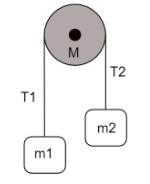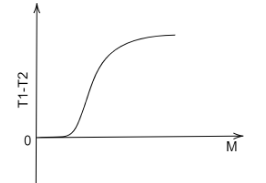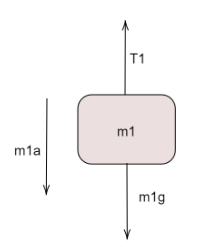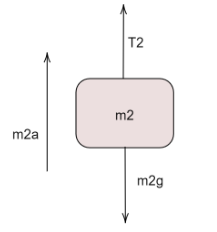
On a pulley of mass $ M $ hangs a rope with two masses $ {m_1} $ and $ {m_2} $ $ ({m_1} > {m_2}) $ tied at the ends as shown in the figure. The pulley rotates without any friction whereas the friction between the rope and the pulley is large enough to prevent any slipping. Which of the following plots best represents the difference between the tensions in the rope on the two sides of the pulley as a function of the mass of the pulley?

(A)

(B)

(C)

(D)






Answer
552.6k+ views
Hint: In order to find the difference, we first draw the free body diagrams of both masses, and balance the forces. We then add both of these equations, this is the first equation. The torque on the pulley is then equated with the tension in the rope, which gives rise to a second equation. Both of these equations are then combined to define the relation of $ {T_1} - {T_2} $ with mass of the pulley $ M $ .
Complete step by step solution
It is given in the question that the pulley rotates without friction and the rope connecting the masses $ {m_1} $ and $ {m_2} $ does not slip.
It is also mentioned that $ {m_1} > {m_2} $ . This means that the rope will move towards $ {m_1} $ and it will go down while $ {m_2} $ will accelerate upwards.
As they both are connected via rope, the acceleration of both blocks would be the same, but in opposite directions.
Therefore drawing the free body diagrams of both masses assuming these conditions,
For block $ {m_1} $ ,

Balancing the vertical forces and acceleration,
$ {m_1}a = {m_1}g - {T_1} $ …(a)
For block $ {m_2} $ ,

Balancing the vertical forces and acceleration,
$ {m_2}a = {T_2} - {m_2}g $ …(b)
Adding equations (a) and (b), we obtain-
$ {m_1}a + {m_2}a = {m_1}g - {T_1} + {T_2} - {m_2}g $
On rearranging this,
$ \left( {{m_1} + {m_2}} \right)a = \left( {{m_1} - {m_2}} \right)g - \left( {{T_1} - {T_2}} \right) $ … $ (1) $
Now, on drawing the free body diagram of the pulley,

We see an angular acceleration of the pulley, which is caused by the turning of the rope around it, therefore the linear component of this acceleration must be equal to the torque produced by the rope.
$ \tau = \left( {{T_1} - {T_2}} \right)r $ ...(c)
(The difference in the tensile forces is used as the torque to produce rotation in the pulley.)
Also,
$ \tau = I\alpha $
where $ \alpha $ is the angular acceleration of the pulley while $ I $ is the moment of inertia of the pulley.
For a circular disk, the Moment of inertia about its central axis of rotation is given by,
$ I = \dfrac{{m{r^2}}}{2} $
Keeping the mass of the pulley equal to $ M $ and its radius equal to $ r $ ,
The torque is,
$ \tau = \dfrac{{M{r^2}\alpha }}{2} $ …(d)
On equating (c) and (d) we get,
$ \tau = ({T_1} - {T_2})r = \dfrac{{M{r^2}\alpha }}{2} $
$ \Rightarrow {T_1} - {T_2} = \dfrac{{Mr\alpha }}{2} $
Writing in terms of linear acceleration using the relation,
$ a = r\alpha $
we have,
$ {T_1} - {T_2} = \dfrac{{Ma}}{2} $
$ a = \dfrac{{2({T_1} - {T_2})}}{M} $ … $ (2) $
Substituting the value of $ a $ in equation $ (1) $ , we get-
$ \left( {{m_1} + {m_2}} \right)\left( {\dfrac{{2({T_1} - {T_2})}}{M}} \right) = \left( {{m_1} - {m_2}} \right)g - \left( {{T_1} - {T_2}} \right) $
Dividing both sides with $ {T_1} - {T_2} $ ,
$ \left( {{m_1} + {m_2}} \right)\left( {\dfrac{2}{M}} \right) = \dfrac{{\left( {{m_1} - {m_2}} \right)g}}{{{T_1} - {T_2}}} - 1 $
$ \Rightarrow \dfrac{{2\left( {{m_1} + {m_2}} \right)}}{M} + 1 = \dfrac{{\left( {{m_1} - {m_2}} \right)g}}{{{T_1} - {T_2}}} $
Upon cross multiplying we get,
$ {T_1} - {T_2} = \dfrac{{\left( {{m_1} - {m_2}} \right)g}}{{\left( {\dfrac{{2({m_1} + {m_2})}}{M} + 1} \right)}} $
$ \Rightarrow {T_1} - {T_2} = \dfrac{{M\left( {{m_1} - {m_2}} \right)g}}{{2({m_1} + {m_2}) + M}} $
$ M $ is present in both, the numerator and the denominator of the relation.
As the value of $ M $ is increased, the difference in the values of $ {T_1} $ and $ {T_2} $ diminishes.
Therefore, the graph which best represents this relation is option (C), hence it is the answer.
Note
For a fixed value of $ {m_1} $ and $ {m_2} $ , since $ {m_1} > {m_2} $ the numerator always remains a positive quantity. With the increase in the value of $ M $ , the overall value of the term increases but the rate of this increment slows down.
Complete step by step solution
It is given in the question that the pulley rotates without friction and the rope connecting the masses $ {m_1} $ and $ {m_2} $ does not slip.
It is also mentioned that $ {m_1} > {m_2} $ . This means that the rope will move towards $ {m_1} $ and it will go down while $ {m_2} $ will accelerate upwards.
As they both are connected via rope, the acceleration of both blocks would be the same, but in opposite directions.
Therefore drawing the free body diagrams of both masses assuming these conditions,
For block $ {m_1} $ ,

Balancing the vertical forces and acceleration,
$ {m_1}a = {m_1}g - {T_1} $ …(a)
For block $ {m_2} $ ,

Balancing the vertical forces and acceleration,
$ {m_2}a = {T_2} - {m_2}g $ …(b)
Adding equations (a) and (b), we obtain-
$ {m_1}a + {m_2}a = {m_1}g - {T_1} + {T_2} - {m_2}g $
On rearranging this,
$ \left( {{m_1} + {m_2}} \right)a = \left( {{m_1} - {m_2}} \right)g - \left( {{T_1} - {T_2}} \right) $ … $ (1) $
Now, on drawing the free body diagram of the pulley,

We see an angular acceleration of the pulley, which is caused by the turning of the rope around it, therefore the linear component of this acceleration must be equal to the torque produced by the rope.
$ \tau = \left( {{T_1} - {T_2}} \right)r $ ...(c)
(The difference in the tensile forces is used as the torque to produce rotation in the pulley.)
Also,
$ \tau = I\alpha $
where $ \alpha $ is the angular acceleration of the pulley while $ I $ is the moment of inertia of the pulley.
For a circular disk, the Moment of inertia about its central axis of rotation is given by,
$ I = \dfrac{{m{r^2}}}{2} $
Keeping the mass of the pulley equal to $ M $ and its radius equal to $ r $ ,
The torque is,
$ \tau = \dfrac{{M{r^2}\alpha }}{2} $ …(d)
On equating (c) and (d) we get,
$ \tau = ({T_1} - {T_2})r = \dfrac{{M{r^2}\alpha }}{2} $
$ \Rightarrow {T_1} - {T_2} = \dfrac{{Mr\alpha }}{2} $
Writing in terms of linear acceleration using the relation,
$ a = r\alpha $
we have,
$ {T_1} - {T_2} = \dfrac{{Ma}}{2} $
$ a = \dfrac{{2({T_1} - {T_2})}}{M} $ … $ (2) $
Substituting the value of $ a $ in equation $ (1) $ , we get-
$ \left( {{m_1} + {m_2}} \right)\left( {\dfrac{{2({T_1} - {T_2})}}{M}} \right) = \left( {{m_1} - {m_2}} \right)g - \left( {{T_1} - {T_2}} \right) $
Dividing both sides with $ {T_1} - {T_2} $ ,
$ \left( {{m_1} + {m_2}} \right)\left( {\dfrac{2}{M}} \right) = \dfrac{{\left( {{m_1} - {m_2}} \right)g}}{{{T_1} - {T_2}}} - 1 $
$ \Rightarrow \dfrac{{2\left( {{m_1} + {m_2}} \right)}}{M} + 1 = \dfrac{{\left( {{m_1} - {m_2}} \right)g}}{{{T_1} - {T_2}}} $
Upon cross multiplying we get,
$ {T_1} - {T_2} = \dfrac{{\left( {{m_1} - {m_2}} \right)g}}{{\left( {\dfrac{{2({m_1} + {m_2})}}{M} + 1} \right)}} $
$ \Rightarrow {T_1} - {T_2} = \dfrac{{M\left( {{m_1} - {m_2}} \right)g}}{{2({m_1} + {m_2}) + M}} $
$ M $ is present in both, the numerator and the denominator of the relation.
As the value of $ M $ is increased, the difference in the values of $ {T_1} $ and $ {T_2} $ diminishes.
Therefore, the graph which best represents this relation is option (C), hence it is the answer.
Note
For a fixed value of $ {m_1} $ and $ {m_2} $ , since $ {m_1} > {m_2} $ the numerator always remains a positive quantity. With the increase in the value of $ M $ , the overall value of the term increases but the rate of this increment slows down.
Recently Updated Pages
Master Class 11 Economics: Engaging Questions & Answers for Success

Master Class 11 English: Engaging Questions & Answers for Success

Master Class 11 Social Science: Engaging Questions & Answers for Success

Master Class 11 Biology: Engaging Questions & Answers for Success

Class 11 Question and Answer - Your Ultimate Solutions Guide

Master Class 11 Business Studies: Engaging Questions & Answers for Success

Trending doubts
10 examples of friction in our daily life

One Metric ton is equal to kg A 10000 B 1000 C 100 class 11 physics CBSE

Difference Between Prokaryotic Cells and Eukaryotic Cells

1 Quintal is equal to a 110 kg b 10 kg c 100kg d 1000 class 11 physics CBSE

Explain zero factorial class 11 maths CBSE

What is a periderm How does periderm formation take class 11 biology CBSE




